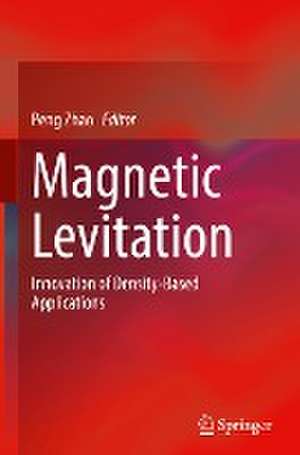Magnetic Levitation: Innovation of Density-Based Applications
Editat de Peng Zhaoen Limba Engleză Hardback – 5 ian 2024
This book would benefit the audience in the field of mechanical engineering, chemistry, materials science,and bioengineering, since magnetic levitation method has proved itself suitable for the density-based analysis and applications of materials of different scales. The analysis in this book will help the audience deeply understand the mechanism of magnetic levitation, and it can serve as an instruction for the magnetic levitation procedure, or guidebook for the magnetic levitation setup. With the viewpoints and thoughts about MagLev running through this book, this book may spark the audience’s interest towards magnetic levitation method, and enlighten them to further develop Maglev method.
Preț: 843.77 lei
Preț vechi: 1110.22 lei
-24% Nou
Puncte Express: 1266
Preț estimativ în valută:
161.55€ • 168.23$ • 134.04£
161.55€ • 168.23$ • 134.04£
Carte tipărită la comandă
Livrare economică 10-17 februarie
Preluare comenzi: 021 569.72.76
Specificații
ISBN-13: 9789819983131
ISBN-10: 9819983134
Pagini: 210
Ilustrații: VII, 210 p. 118 illus., 100 illus. in color.
Dimensiuni: 155 x 235 mm
Greutate: 0.57 kg
Ediția:1st ed. 2024
Editura: Springer Nature Singapore
Colecția Springer
Locul publicării:Singapore, Singapore
ISBN-10: 9819983134
Pagini: 210
Ilustrații: VII, 210 p. 118 illus., 100 illus. in color.
Dimensiuni: 155 x 235 mm
Greutate: 0.57 kg
Ediția:1st ed. 2024
Editura: Springer Nature Singapore
Colecția Springer
Locul publicării:Singapore, Singapore
Cuprins
Chapter 1. Magnetism and Magnetic Materials.- Chapter 2. Development of Magneto-Archimedes Levitation-. Chapter 3. Magnetic forces.- Chapter 4. Stable levitation.- Chapter 5. Standard magnetic levitation testing method.- Chapter 6. Optimization of magnetic levitation testing method.- Chapter 7. Magnetic levitation in Mechanical Engineering.- Chapter 8. Magnetic levitation in Chemistry and Materials Science.- Chapter 9. Magnetic levitation in Medicine and Bioengineering.- Chapter 10. Self-Assembly via magnetic levitation.- Chapter 11. Manipulation via magnetic levitation.- Chapter 12. One Step Separation via magnetic levitation.
Notă biografică
Peng Zhao is the professor and the deputy dean of School of Mechanical Engineering in Zhejiang University. Prof. Zhao is a member of the Council of the Plastic Engineering Branch of the Chinese Mechanical Engineering Society, and the vice director of Plastics Mold Committee in China Die & Mold Industry Association. His research mainly focuses on magnetic levitation (MagLev), polymer injection molding, and magnetic soft robotics. He has published over 90 papers on influential journals, such as Advanced Functional Materials, Nano Energy, and Analytical Chemistry. He has also been granted more than 50 Chinese patents during his career.
Textul de pe ultima copertă
This book introduces the MagLev testing method for density measurement and density-based applications of diamagnetic and low-magnetic objects using permanent magnets. The book surveys the most relevant papers on the theory and model of various MagLev methods that have become the foundation to elucidate the principles of MagLev and the conditions for stable levitation. A thorough summary of the improvements demonstrates the applications and potential of the MagLev method in many fields. This book is separated into 11 chapters to present MagLev testing method fully, including a review of the background of MagLev, theories and basic principles of the stable levitation of object, different dimensions of applications of MagLev in the fields of mechanical engineering, chemistry, and bioengineering, and sophisticated applications of manipulation and separation.
This book would benefit the audience in the field of mechanical engineering, chemistry, materials science,and bioengineering, since magnetic levitation method has proved itself suitable for the density-based analysis and applications of materials of different scales. The analysis in this book will help the audience deeply understand the mechanism of magnetic levitation, and it can serve as an instruction for the magnetic levitation procedure, or guidebook for the magnetic levitation setup. With the viewpoints and thoughts about MagLev running through this book, this book may spark the audience’s interest towards magnetic levitation method, and enlighten them to further develop Maglev method.
This book would benefit the audience in the field of mechanical engineering, chemistry, materials science,and bioengineering, since magnetic levitation method has proved itself suitable for the density-based analysis and applications of materials of different scales. The analysis in this book will help the audience deeply understand the mechanism of magnetic levitation, and it can serve as an instruction for the magnetic levitation procedure, or guidebook for the magnetic levitation setup. With the viewpoints and thoughts about MagLev running through this book, this book may spark the audience’s interest towards magnetic levitation method, and enlighten them to further develop Maglev method.
Caracteristici
Introduces the novel magnetic levitation (MagLev) method for density measurement and density-based applications Provides a comprehensive overview of the history, theories, and applications of MagLev Illustrates the interesting and characteristic phenomena during levitation
